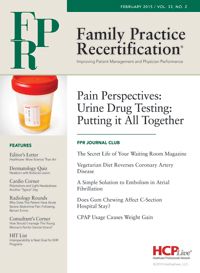Publication
Article
Family Practice Recertification
Healthcare: Becoming More Science Than Art
Author(s):
A veteran in the field of medicine gets a bird's eye view of life from the patient's perspective

During a medical career that now spans three decades, I have witnessed dramatic changes in the way medicine is practiced. Compared to when I started, technological advances have revolutionized not only how patients are diagnosed and treated but also the healthcare system and environment in which they are seen.
Although familiar with these changes from a physician’s perspective, during the recent holiday season I experienced it first-hand from the patient’s end. How? I presented to the emergency room (ER) on Christmas Eve for progressive periumbilical abdominal pain and saw for myself our healthcare system in action.
Despite the oft-cited emphasis on “patient-centered” care, my experience seemed anything but. Greeted as “Mr. Quan” by the clerk at the admitting desk, the eyes of the ER clerk and the triage nurse never moved from the computer monitor in front of them as they peppered me with a scripted assortment of close-ended questions covering a wide variety of areas, including my illness, insurance coverage, allergies, social habits, family history, recent immunizations, recent travel to West Africa, and whether I was still taking the 7 medications they had listed for me. This list included 4 antibiotics that had been prescribed for me in the remote past. As opposed to being “patient-centric”, it was obvious the staff was more “encounter-centric” with their primary focus being the data entry called for by the electronic medical record (EMR).
I was then taken to an exam room and the next person I saw was a surgical resident. He performed a very cursory history and his physical examination was limited to palpation and auscultation of my abdomen. He seemed much more interested in using the bedside ultrasound in the room. During the exam, he proudly informed me he saw no evidence of gallstones or an abdominal aorta aneurysm.
The ER attending followed and he advised me a CT scan of the abdomen was needed to rule out appendicitis. He said the nurse would be in shortly to draw my serum creatinine after which I would be sent to radiology.
Seventy minutes passed before the nurse entered the room. She apologized for the delay and explained that no one had told her I was in her room and that the EMR failed to cue her to my presence.
She proceeded to draw my blood and start an intravenous line, taking special care to scan my ID wristband prior to scanning the barcode of items used in my care.
A CT scan with contrast was performed and the intern informed me that it was “negative and normal” and I was discharged. Three hours later I returned to the emergency room because the pain progressed to a “9” and had shifted to the right lower abdomen, although above McBurney’s point. When I asked the E.R. attending how well the CT scan displayed my appendix, he revealed that the “wet read” was not completely accurate and that the final report read the appendix was “not well-visualized” but “did not appear abnormal”.
I was admitted to the hospital for observation and my experience was more of the same. The medical intern, resident, and attending on the service to which I was admitted spent a few minutes with me in the morning and examined my lungs, heart, and abdomen. A rectal exam was never performed. What about a Rovsing’s sign? A psoas sign? An obturator sign? Or a Dunphy sign? Although negative based on my improvised self-exam they were never performed by any of my physicians. When I asked if a surgical consult was being considered, I was reassured that it was not necessary since upon further review, one of the GI radiologists was able to make out a “stubby” appendix and that it appeared normal.
Nursing and ancillary staff popped in and out of my room throughout my stay. Although they smiled and greeted me by name, very little personal contact was provided. My only extended interaction occurred the first night when I spiked a fever and blood tests and 2 sets of blood cultures were drawn. Much of their time in the room was spent with the EMR, transcribing notes, checking boxes, clicking through drop-down menus, and scanning barcodes.
Following more than 30 hours of observation, and a few doses of an IV opiate, my abdominal pain improved and my appetite returned. Although the unit staff knew hours in advance I would be discharged late in the afternoon if I tolerated a liquid breakfast and soft diet lunch without incident neither my discharge medications nor a patient escort was available at the time my wife came to take me home. I was provided a lengthy 5-page discharge summary and follow-up instructions. Although its utility was limited by a startling lack of detail or accuracy, I would bet it contained all the elements required to meet guidelines for meaningful use.
Overall, my patient experience was certainly a positive one. I have little doubt that without the “negative” CAT scan I would be “minus an appendix” given the pattern of my abdominal pain and my low-grade fever and a slightly elevated white count. On the other hand, I must profess disappointment in seeing how impersonal healthcare has become, with technology (including the EMR) and the drive for documentation seemingly taking precedent over the interpersonal aspects of patient care.
Beginning the first day of medical school, it has traditionally been ingrained in doctors that medicine is both an “art” and “science”. As foreshadowed in the futuristic Star Trek television series in the late 1960’s (where Dr. McCoy needed only a medical “tricorder” to diagnosis a patient), it is becoming apparent the “science” has come to outweigh the “art”.






